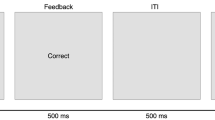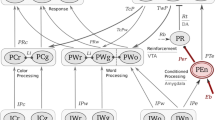Abstract
A tendency to ruminate or repetitively think about depressed mood is associated with increased perseveration in the Wisconsin Card Sorting Task (Davis and Nolen-Hoeksema in Cogn Ther Res 24:699–711, 2000). In the current study, we used a reversal learning task to determine if trait ruminators’ perseveration could be driven, at least in part, by a cognitive process called reversal learning, that is, the ability to learn from feedback of the need to reverse stimulus-reward associations. We also examined whether reversal learning would be generally associated with repetitive thought regardless of whether it is maladaptive (depressive brooding, anger rumination, and worry) or adaptive (intellectual selfreflection, and depressive reflection). The results suggest that a tendency to engage in repetitive thought, regardless of its adaptiveness, is related to difficulties reversing stimulus-reward associations but not to the ability to initially learn reward associations.

Similar content being viewed by others
Notes
We would like to note that we did not find a relation between gender and reversal learning scores or initial discrimination scores, all P’s > .1. Gender also did not modify any of the relationships found between repetitive thought and the task measures, all P’s > .1.
References
Altamirano, L., Miyake, A., & Whitmer, A. (2010). When mental inflexibility facilitates executive control: Beneficial side effects of ruminative tendencies on goal maintenance. Psychological Science, 21, 1377–1382.
Beck, A. T., Ward, C. H., Mendelson, M., Mock, J., & Erbaugh, J. (1961). An inventory for measuring depression. Archives of General Psychiatry, 4, 561–571.
Blair, R. J., Colledge, E., & Mitchell, D. G. (2001). Somatic markers and response reversal: Is there orbitofrontal cortex dysfunction in boys with psychopathic tendencies? Journal of Abnormal Child Psychology, 29, 499–511.
Clark, L., Cools, R., & Robbins, T. W. (2004). The neuropsychology of ventral prefrontal cortex: Decision-making and reversal learning. Brain and Cognition, 55, 41–53.
Davis, R. N., & Nolen-Hoeksema, S. (2000). Cognitive inflexibility among ruminators and nonruminators. Cognitive Therapy and Research, 24, 699–711.
Dias, R., Robbins, T. W., & Roberts, A. C. (1996). Dissociation in prefrontal cortex of affective and attentional shifts. Nature, 380, 69–72.
Downes, J. J., Roberts, A. C., Sahakian, B. J., Evenden, J. L., Morris, R. G., & Robbins, T. W. (1989). Impaired extra-dimensional shift performance in medicated and unmedicated Parkinson’s disease: Evidence for a specific attention dysfunction. Neuropsychologia, 27, 1329–1343.
Fresco, D. M., Frankel, A., Mennin, D. S., Turk, C. L., & Heimberg, R. G. (2002). Distinct and overlapping features of rumination and worry: The relationship of cognitive production to negative affective states. Cognitive Therapy and Research, 26, 179–188.
Jones, N. P., Papadakis, A. A., Hogan, C. M., & Strauman, T. J. (2009). Over and over again: Rumination, reflection, promotion goal failure, and their interactive effects on depressive symptoms. Behavior Research and Therapy, 47, 254–259.
Joormann, J. (2006). Differential effects of rumination and dysphoria on the inhibition of irrelevant emotional material: Evidence from a negative priming task. Cognitive Therapy and Research, 30, 149–160.
Joormann, J., Dkane, M., & Gotlib, I. H. (2006). Adaptive and maladaptive components of rumination? Diagnostic specificity and relation to depressive biases. Behavior Therapy, 37, 269–280.
MacLeod, C., Rutherford, E., Campbell, L., Ebsworthy, G., & Holker, L. (2002). Selective attention and emotional vulnerability: Assessing the causal basis of their association through the experimental manipulations of attentional bias. Journal of Abnormal Psychology, 111, 107–123.
Meyer, T. J., Miller, M. L., Metzger, R. L., & Borkovec, T. D. (1990). Development and validation of the Penn State Worry Questionnaire. Behaviour Research and Therapy, 28, 487–495.
Nolen-Hoeksema, S. (2000). The role of rumination in depressive disorders and mixed anxiety/depressive symptoms. Journal of Abnormal Psychology, 109, 504–511.
Nolen-Hoeksema, S., & Morrow, J. (1991). A prospective study of depression and posttraumatic stress symptoms after a natural disaster: The 1989 Loma Prieta earthquake. Journal of Personality and Social Psychology, 61, 115–121.
Nolen-Hoeksema, S., Wisco, B., & Lyubomirsky, S. (2008). Rethinking rumination. Perspectives on Psychological Science, 3, 400–424.
Roberts, J. E., Gilboa, E., & Gotlib, I. H. (1998). Ruminative response style and vulnerability to episodes of dysphoria: Gender, neuroticism, and episode duration. Cognitive Therapy and Research, 22, 401–423.
Sukhodolsky, D. G., Golub, A., & Cromwell, E. N. (2001). Development and validation of the anger rumination scale. Personality and Individual Differences, 31, 689–700.
Takano, K., & Tanno, Y. (2009). Self-rumination, self-reflection, and depression: Self-rumination counteracts the adaptive effect of self-reflection. Behaviour Research and Therapy, 33, 260–264.
Trapnell, P. D., & Campbell, J. D. (1999). Private self-consciousness and the five-factor model of personality: Distinguishing rumination from reflection. Journal of Personality and Social Psychology, 76, 284–304.
Treynor, W., Gonzalez, R., & Nolen-Hoeksema, S. (2003). Rumination reconsidered: A psychometric analysis. Cognitive Therapy and Research, 27, 247–259.
Watkins, E. (2008). Constructive and unconstructive repetitive thought. Psychological Bulletin, 134, 163–206.
Watson, D., Clark, L. A., & Tellegen, A. (1988). Development and validation of brief measures of positive and negative affect: The PANAS scales. Journal of Personality and Social Psychology, 54, 1063–1070.
Whitmer, A., & Banich, M. (2007). Inhibition versus switching deficits in different forms of rumination. Psychological Science, 18, 546–553.
Whitmer, A., & Banich, M. (2010). Trait rumination and inhibitory deficits in long-term memory. Cognition and Emotion, 1, 168–179.
Author information
Authors and Affiliations
Corresponding author
Rights and permissions
About this article
Cite this article
Whitmer, A.J., Banich, M.T. Repetitive Thought and Reversal Learning Deficits. Cogn Ther Res 36, 714–721 (2012). https://doi.org/10.1007/s10608-011-9409-4
Published:
Issue Date:
DOI: https://doi.org/10.1007/s10608-011-9409-4




